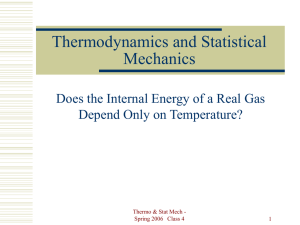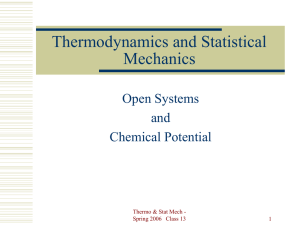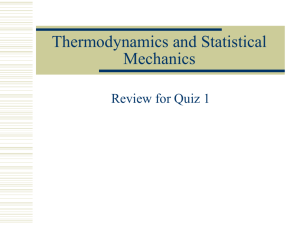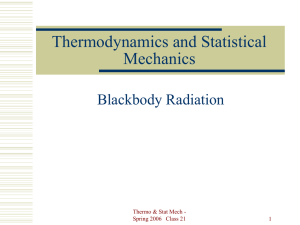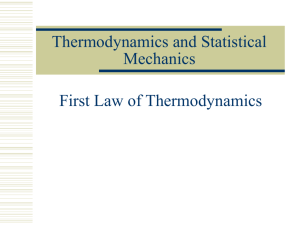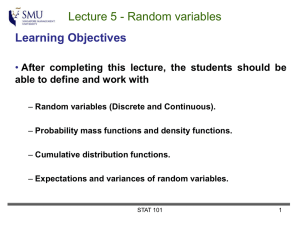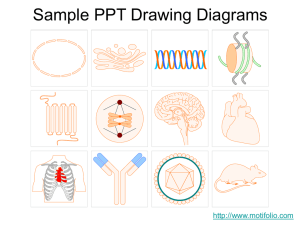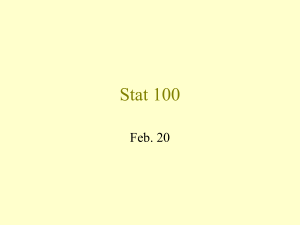Session 19
advertisement
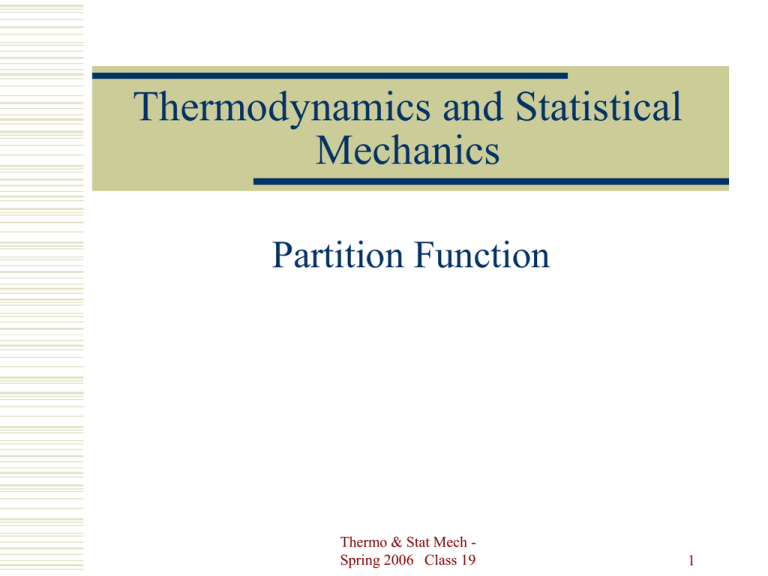
Thermodynamics and Statistical
Mechanics
Partition Function
Thermo & Stat Mech Spring 2006 Class 19
1
Free Expansion of a Gas
Thermo & Stat Mech - Spring 2006
Class 19
2
Free Expansion
Thermo & Stat Mech - Spring 2006
Class 19
3
Isothermal Expansion
Thermo & Stat Mech - Spring 2006
Class 19
4
Isothermal Expansion
Reversible route between same states.
f
dQ
S
T
i
đQ = đW + dU
Since T is constant, dU = 0.
Then, đQ = đW.
nRT
dW PdV
dV
V
dQ dW nRT dV
dV
dS
nR
T
T
T V
V
Thermo & Stat Mech - Spring 2006
Class 19
5
Entropy Change
2V
dV
2V
S nR
nR ln nR ln 2
V
V
V
The entropy of the gas increased.
For the isothermal expansion, the entropy of the
Reservoir decreased by the same amount.
So for the system plus reservoir, S = 0
For the free expansion, there was no reservoir.
Thermo & Stat Mech - Spring 2006
Class 19
6
Statistical Approach
wf
S S f S i k ln w f k ln wi k ln
wi
N!
wi
1
N !0!
N!
N!
wf
2
( N / 2)!( N / 2)! ( N / 2)!
Thermo & Stat Mech - Spring 2006
Class 19
7
Statistical Approach
wf
N!
k ln
S k ln
2
( N / 2)!
w
i
S k[ln N !2 ln(N / 2)!]
S k[ N ln N N 2{( N / 2) ln(N / 2) N / 2}]
N
S k[ N ln N N ln(N / 2)] Nk ln
N/ 2
S Nk ln 2 nR ln 2
Thermo & Stat Mech - Spring 2006
Class 19
8
Partition Function
Nj N
g je
n
g je
j
j
j 1
n
g je
j
Z
PartitionFunction
j 1
Nj N
g je
j
Z
Thermo & Stat Mech - Spring 2006
Class 19
9
Boltzmann Distribution
Nj N
g je
n
g je
j
j
j 1
n
n
j N j U N
j 1
j g je
j 1
n
g je
j
j
j 1
Z
U
ln Z
N
Z
Thermo & Stat Mech - Spring 2006
Class 19
10
Maxwell-Boltzmann Distribution
Correct classical limit of quantum
statistics is Maxwell-Boltzmann
distribution, not Boltzmann.
What is the difference?
Thermo & Stat Mech - Spring 2006
Class 19
11
Maxwell-Boltzmann Probability
n
( N j g j 1)!
j 1
N j !( g j 1)!
wBE
Nj
j
n
g
j 1
N j!
wB N!
n
g j!
j 1
N j !( g j N j )!
wFD
Nj
j
n
g
j 1
N j!
wMB
wB and wMB yield the same distribution.
Thermo & Stat Mech - Spring 2006
Class 19
12
Relation to Thermodynamics
U N j j
j
dU j dN j N j d j
j
j j ( X ),
j
so
d j
d j
dX
dX
d j
dU j dN j N j
dX
dX
j
j
d j
Call N j
Y
dX
j
Thermo & Stat Mech - Spring 2006
Class 19
13
Relation to Thermodynamics
d j
dU j dN j N j
dX and
dX
j
j
dU j dN j YdX T hisis like
d j
j N j dX Y
j
dU TdS YdX
If dX 0
(or dU TdS PdV )
(dU ) X j dN j TdS and
j
N d
j
j
YdX
j
Thermo & Stat Mech - Spring 2006
Class 19
14
Chemical Potential
dU = TdS – PdV + mdN
In this equation, m is the chemical energy
per molecule, and dN is the change in the
number of molecules.
Thermo & Stat Mech - Spring 2006
Class 19
15
Chemical Potential
dU TdS PdV mdN
F U TS
dF TdS PdV mdN TdS SdT
dF SdT PdV mdN
F
m
N T ,V
Thermo & Stat Mech - Spring 2006
Class 19
16
Entropy
S k ln wMB
Nj
n
gj
j 1
N j!
where wMB
S k N j ln g j ln N j !
j
j
S k N j ln g j N j ln N j N j
j
j
j
N j
S k N N j ln
g
j
j
Thermo & Stat Mech - Spring 2006
Class 19
17
Entropy
Nj
S k N N j ln
g
j
j
Nj
N
e
gj Z
j
kT
j
S k N N j ln N N j ln Z N j
kT
j
j
j
U
S Nk (ln Z ln N 1)
T
Thermo & Stat Mech - Spring 2006
Class 19
18
Helmholtz Function
U
S Nk (ln Z ln N 1)
T
U
F U TS U T NkT (ln Z ln N 1)
T
F NkT (ln Z ln N 1)
Thermo & Stat Mech - Spring 2006
Class 19
19
Chemical Potential
F NkT (ln Z ln N 1)
F
m
N T ,V
1
m kT (ln Z ln N 1) NkT
N
N
m kT (ln N ln Z ) kT ln
Z
Thermo & Stat Mech - Spring 2006
Class 19
20
Chemical Potential
N
m kT ln so
Z
m
T hen
So,
e
m
kT
kT
m
N
ln
kT
Z
N
Z
Thermo & Stat Mech - Spring 2006
Class 19
21
Boltzmann Distribution
N j e g j e
n
Nj N e
j
j 1
e
n
g je
j
j 1
N
n
g je
j
j 1
Nj N
g je
n
g je
j
j
j 1
Thermo & Stat Mech - Spring 2006
Class 19
22
Distributions
Nj
gj
Nj
gj
Nj
gj
1
e
j
fj
1
e
j
1
1
e
j
1
Boltzmann
fj
Bose - Einstein
fj
Fermi- Dirac
Thermo & Stat Mech - Spring 2006
Class 19
23
Distributions
Nj
gj
Nj
gj
Nj
gj
1
j m
e
fj
kT
1
j m
e
kT
j m
e
kT
fj
Bose - Einstein
fj
Fermi- Dirac
1
1
Boltzmann
1
Thermo & Stat Mech - Spring 2006
Class 19
24
Ideal Gas
3/ 2
2 m kT
Z V
2
h
F NkT (ln Z ln N 1)
3 2 m kT
ln N 1
F NkT ln V ln
2
2 h
Thermo & Stat Mech - Spring 2006
Class 19
25
Ideal Gas
3 2 m kT
ln N 1
F NkT ln V ln
2
2 h
1
F
P
NkT
V
V T , N
PV NkT nRT
Thermo & Stat Mech - Spring 2006
Class 19
26
Ideal Gas
2 m kT
Z V
2
h
3/ 2
2 m
V 2
h
3/ 2
3/ 2
2 m
3
ln Z ln V 2 ln
2
h
U
ln Z 3 1 3
kT
N
2 2
Thermo & Stat Mech - Spring 2006
Class 19
27
Entropy
U
S Nk (ln Z ln N 1)
T
2 m kT
ln Z ln V
2
h
3/ 2
3/ 2
kT
m
2
V
3NkT
1
Nk ln
S
N h 2
2T
3/ 2
5
kT
m
2
V
S Nk ln
2
N h 2
Thermo & Stat Mech - Spring 2006
Class 19
28
Math Tricks
For a system with levels that have a constant
spacing (e.g. harmonic oscillator) the partition
function can be evaluated easily. In that case, n
= n, so,
Z e
n
n 0
e
n 0
n
e
n
n 0
1
1
x
1 x 1 e
n 0
n
Thermo & Stat Mech - Spring 2006
Class 19
for e β ε 1.
29
Heat Capacity of Solids
Each atom has 6 degrees of freedom, so based
on equipartition, each atom should have an
average energy of 3kT. The energy per mole
would be 3RT. The heat capacity at constant
volume would be the derivative of this with
respect to T, or 3R. That works at high enough
temperatures, but approaches zero at low
temperature.
Thermo & Stat Mech - Spring 2006
Class 19
30
Heat Capacity
Einstein found a solution by treating the solid
as a collection of harmonic oscillators all of the
same frequency. The number of oscillators was
equal to three times the number of atoms, and
the frequency was chosen to fit experimental
data for each solid. Your class assignment is to
treat the problem as Einstein did.
Thermo & Stat Mech - Spring 2006
Class 19
31
Heat Capacity
Heat Capacity
30
25
Cv (J/K)
20
15
10
5
0
-5 0
100
200
300
400
T (K)
Thermo & Stat Mech - Spring 2006
Class 19
32
